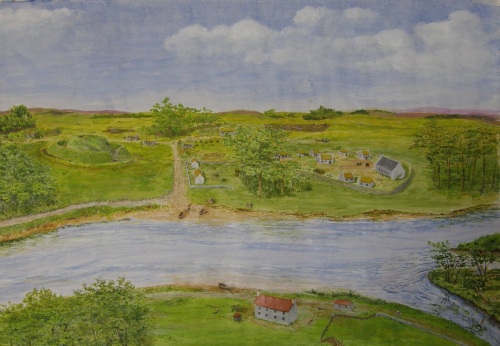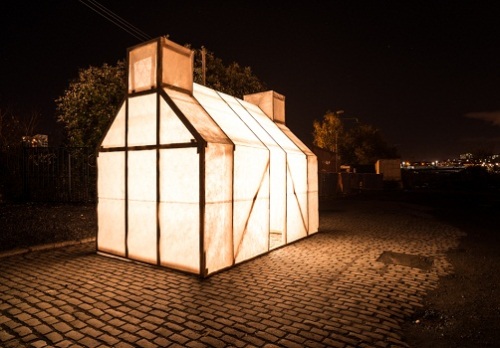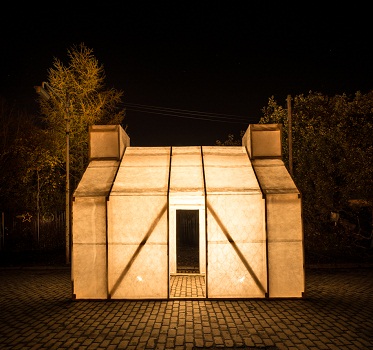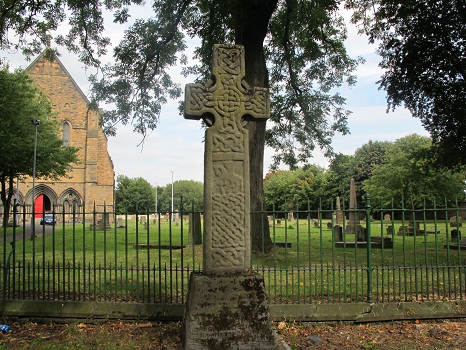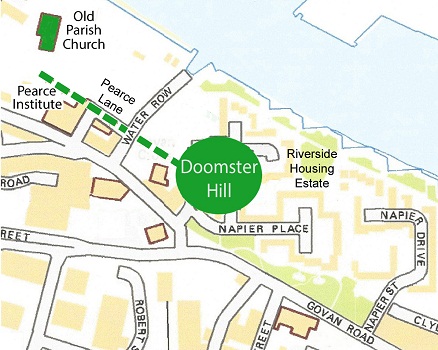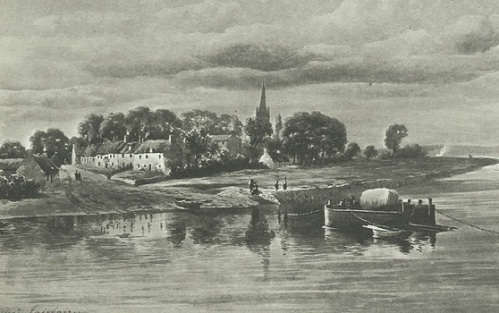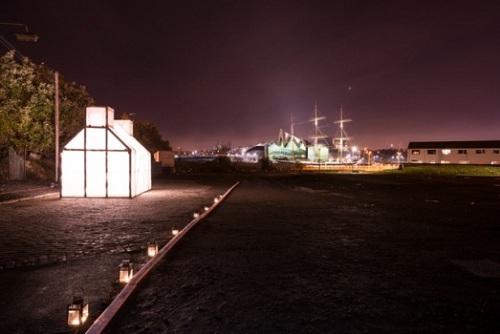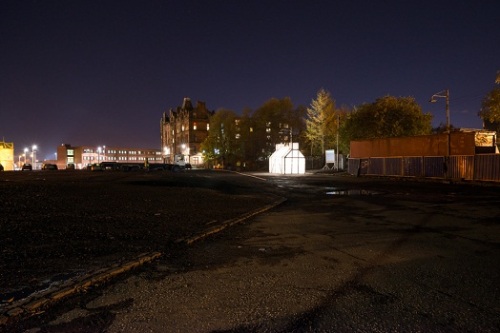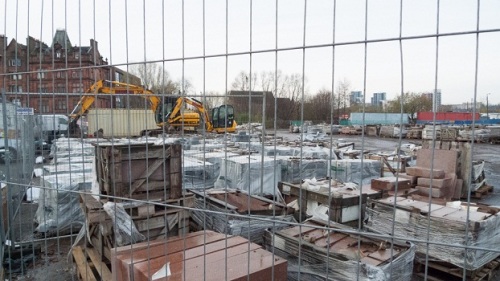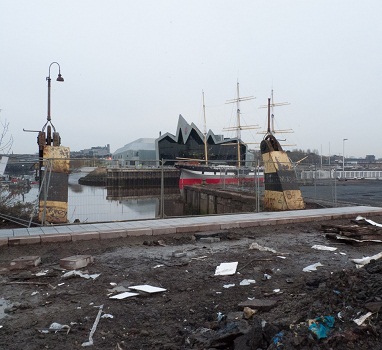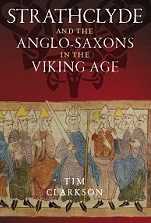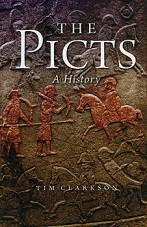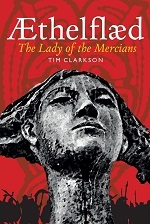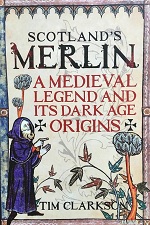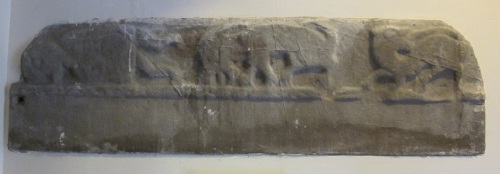
Copyright © B Keeling
Just inside the entrance to the parish church at Fairlie, North Ayrshire, is a well-preserved example of ‘Govan School’ sculpture. This is the Fairlie Stone, the last surviving portion of a recumbent (horizontal) monument designed to cover a grave. Its carvings are remarkably similar to those on a recumbent cross-slab at Inchinnan, near Renfrew, and to other examples of the Govan artistic style. What we are presumably seeing at Fairlie is a section of one of the long sides of a broken cross-slab, the rest of the monument having disappeared without trace.

Copyright © B Keeling
The carvings are clear and easily photographed. Viewed from right to left, we see the common Govan School motif of a beast biting its tail, then a larger beast with open jaws, and finally a man lying on the ground. The large beast seems to be about to attack the man, who has a round shield and a sword. Perhaps he is a casualty of war, lying slain or wounded on a battlefield, with wolves gathering around to devour him?

Copyright © B Keeling

Copyright © B Keeling
By analogy with similar sculpture we can date the Fairlie Stone to the 10th century, or possibly the early 11th. Like the Inchinnan cross-slab it comes from an old religious site, in this case a long-vanished chapel on the Kelburn Estate to the north of Fairlie village. The chapel may have stood on the site of an ancient church and cemetery where high-status local families buried their dead in early medieval times.
It is interesting to note the presence of this type of sculpture – the stonecarving style of the kingdom of Strathclyde – so far from the main centres of power and patronage at Govan and Partick. Indeed, some historians believe that much of Ayrshire lay under the authority not of the Clyde kings but of the fearsome Gall-Gaidhil (‘Foreign Gaels’), a people of mixed Gaelic-Scandinavian heritage who settled the western shorelands of northern Britain in the wake of the first Viking raids. But the Fairlie Stone, together with another example of Govan School sculpture 9 miles south-east at Kilwinning, suggest that either the Gall-Gaidhil commissioned Govan-trained stonemasons to carve their monuments, or that they themselves were vassals of the kings of Strathclyde.
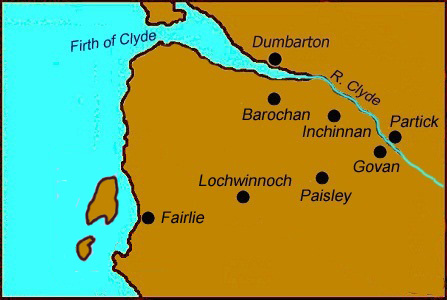
The geographical context of the Fairlie Stone.
Although we know little of the early history of the Fairlie stone, its discovery in modern times is well-documented. It was retrieved during the demolition of Chapel House, a farmhouse erected on the Kelburn Estate in 1745, where it had served as a lintel over a fireplace. At that time it had a coating of black lead, but it was later cleaned before being placed in the garden of St Margaret’s Manse in Fairlie village. From there it was transferred to St Margaret’s Church where it was embedded in a wall inside the entrance. Finally, it was removed again to be inserted in a similar position at St Paul’s Church, now the parish church of Fairlie.
While it lay in the manse garden of St Margaret’s, the stone was described by a local resident, Miss Hutcheson, in the 1894 volume of Proceedings of the Society of Antiquaries of Scotland. The description was accompanied by a photograph taken by Andrew Miller, another Fairlie inhabitant. Although the stone was noted 9 years later in the magisterial Early Christian Monuments of Scotland, it was evidently not viewed in person by the authors Joseph Anderson and John Romilly Allen, who instead cited Miss Hutcheson’s PSAS article as their source.
* * * *
References
Miss Hutcheson, (Untitled description of the Fairlie Stone), Proceedings of the Society of Antiquaries of Scotland, vol.28 (1894) 234-6.
Full-text available online
John Romilly Allen and Joseph Anderson (1903) The Early Christian Monuments of Scotland (Edinburgh: Society of Antiquaries of Scotland) [pp.475 of Part III] Reprinted in facsimile by the Pinkfoot Press in 1993.
[I believe the photograph shown by Allen and Anderson to be Andrew Miller’s from the 1894 article but, because they don’t give Miller a namecheck, it appears uncredited like the photos taken by Allen himself.]
* * * *
Relevant links
The Fairlie Stone described at the Canmore database of RCAHMS
* * * * * * *
